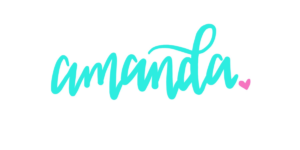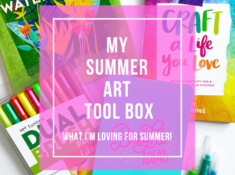This post contains Affliate links. Amanda Kammarada is part of the TombowUSA Affliate Program.
I started lettering 2 years ago and I’m so happy I did. It’s relaxing, fun and I love making words looks pretty. But I wasn’t always happy or excited about my work. I was frustrated when I first started because my lettering didn’t look like the more accomplished letterers I saw on Instagram. But I’m here to tell you right now, don’t give up! So, if you’ve been wanting to start hand lettering or just started, keep reading for some of my helpful tips for beginners. This post will give you the knowledge you need to start and hopefully provide with the confidence to give it a try!
#1 Supplies
A pencil, eraser and some paper are great supplies to get your started. You can practice lettering with a pencil- They aren’t just for drawing! A pencil is great for sketching and playing around with letter forms. You can even achieve the thin and thick lines with a pencil! I love the Tombow MONO Drawing Pencil & Tombow MONO Eraser in white.
But really, let’s talk brush pens. (Cause really that’s what you wanna write with right?) Hands-down my favorite pen for beginners is the Tombow Fudenosuke Soft Tip. This pen is comfortable to hold and the tip is flexible, which in opinion is easy to manipulate when your first learning strokes. The Fudenosuke (trying saying that 3 times fast) comes in a Soft and Hard Tip. You can find them sold as a pack or separately. I encourage to try both and see which one you like best. Most letterers do have a favorite. I prefer the soft– it’s definitely my pick for the best brush pen for beginners.
Now that you have a brush pen, you need the right kind of paper. It’s very important to select smooth paper when using a brush pen. Good paper will prolong the life of your pen and not cause fraying of the tip. My favorite paper (and what I use every day) is Canson Marker Paper. It’s very smooth and see through- which comes in handy if you want to trace. Also, Canson Tracing Paper is great too. I use that over my practice sheets. I can also highly recommend Rhodia pads. They are a bit pricier but so worth the money. Their paper is like butter. Really. Canson Bristol is a good choice as well (Although I do not use it as often as the Marker). COPY/PRINTER PAPER should NOT be used with your brush pens. It may feel smooth to touch but it has tiny fibers in it that will cause fraying of your tips after just a few uses. If you invest in good paper, your pens will last longer and you will have a smoother surface to write on which allows for easier strokes.
# 2 Downstrokes & Upstrokes
An important part of hand lettering is the downstrokes and upstrokes. And it’s all about the amount of pressure you apply to the tip of your pen.
A downstroke is a line that is drawn in a downward direction. These are your thick lines. To achieve a thick downstroke you’ll apply heavy pressure when writing. You’ll want to see the tip of your pen “flatten” out against the paper. Don’t be afraid to press hard- I promise you won’t ruin the tip!
An upstroke is a line that is drawn in an upward direction. These are your thin lines. To achieve a nice thin upstroke, you will want to apply very little pressure as you guide your pen up. I like to think of it as just having your tip “kissing” the paper.
A very important tip— make sure to hold your brush pen at a 40 degree angle. This angle will allow the movement that is needed to achieve those thick and thin strokes.
Basic Strokes & Alphabet Practice
Warming up with the basic strokes is so important. Practicing your upstrokes and downstrokes is part of those basic strokes. These strokes will help to work on your muscle memory and is the basis of writing our letters! So, to help you practice you basic strokes and alphabet, I’m releasing my first set of practice sheets! The set includes the basics, along with a lowercase alphabet. You can find them here in my etsy shop: PRACTICE SHEETS HERE
#3 Practice Makes Progress
My favorite tip for beginners is to practice, practice, practice. It seems so cliche, but seriously, it’s true! At first, you may get discouraged. You will get frustrated. You’ll be judging your lettering with other letterers you see on social media. Put that out of your mind. (I know it’s easier said than done- but it will be a tremendous help!) You can’t compare your beginning to someone else’s middle. We were all beginners at one time. Daily practice is so important. Take some time out your day to practice your basic strokes. Practice the alphabet. Even take an online or in-person class of you can! Rome wasn’t built in a day (I think that’s the saying right?). Well, becoming a master lettering wizard will not just happen day 1. But don’t give up. Practice makes progress. Not perfect. Even after lettering for 2 years, I’m still LEARNING. I’m still practicing.
I pulled out some of my early lettering from 2 years ago. I’ve made huge progress (see it’s possible!) but I’m still practicing every single day.
So, I hope that these tips have helped you to get started with lettering. I promise, you will love it!
Please comment with any other questions you may have- I’d love to answer them!
If you give my practice sheets a try, I would love to see– snap a photo and share on Instagram and tag # AmandaKammarada
Happy Lettering!












 My Summer Art Tool Box
My Summer Art Tool Box My Favorite Eraser for Lettering: Tombow MONO Eraser
My Favorite Eraser for Lettering: Tombow MONO Eraser DIY Mother’s Day Flower Wrapping
DIY Mother’s Day Flower Wrapping
Thank you! Hundred and thousand times!!
You’re welcome!! Happy to help!
Excellent, I will definitely try this at home in free to get better writing. thank you so much for this tips. Keep it up!
Happy to help! Happy Lettering!